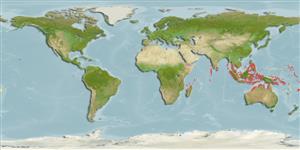分类 / Names
俗名 | 同种异名 | Catalog of Fishes(属, 种) | ITIS | CoL | WoRMS | Cloffa
Teleostei >
Ovalentaria/misc (Various families in series Ovalentaria)
鱸形目 (Various families in series Ovalentaria) >
Pomacentridae (Damselfishes)
雀鯛科(Damselfishes) (Damselfishes) > Pomacentrinae
Etymology: Cheiloprion: Greek, cheilos = lip + Greek, prion = saw (Ref. 45335).
More on author: Day.
Environment: milieu / climate zone / depth range / distribution range
生态学
海洋 礁区鱼类; 非迁移的; 深度上下限 1 - 3 m (Ref. 9710). 熱帶; 15°N - 20°S
Indo-West Pacific: Sri Lanka to the Solomon Islands, north to the Philippines, south to Vanuatu and northern Australia; Palau in Micronesia.
印度-西太平洋: 斯里蘭卡到索羅門群島,北至菲律賓, 南至萬那度與澳洲北部; 在密克羅尼西亞的帛琉 (帛琉)。
大小 / 重量 / 年龄
Maturity: Lm ? range ? - ? cm
Max length : 6.0 cm SL 雄鱼/尚未辨别雌雄; (Ref. 7247)
背棘 (总数) : 13; 背的软条 (总数) : 13 - 14; 臀棘: 2; 臀鳍软条: 13 - 14.
白色而且卷曲背面唇是特殊的, 特别地较大时个体。 稚鱼是暗橘色的虽然成鱼是深褐色的。
Found usually among beds of branching corals in shallow lagoon reefs, singly or in small groups (Ref. 4966). Feed primarily on the polyps of Acropora corals. Diurnal species (Ref. 113699). Oviparous, distinct pairing during breeding (Ref. 205). Eggs are demersal and adhere to the substrate (Ref. 205). Males guard and aerate the eggs (Ref. 205).
通常在水浅的泻湖礁中的树枝状珊瑚的床之中发现, 各别地或形成小群鱼群.(参考文献 4966) 主要吃 Acropora 珊瑚的水螅体。
Life cycle and mating behavior
成熟度 | 繁殖 | 产卵场 | 卵 | 孕卵数 | 仔鱼
Oviparous, distinct pairing during breeding (Ref. 205). Eggs are demersal and adhere to the substrate (Ref. 205). Males guard and aerate the eggs (Ref. 205).印度-西太平洋: 斯里蘭卡到索羅門群島,北至菲律賓, 南至萬那度與澳洲北部; 在密克羅尼西亞的帛琉 (帛琉)。
Allen, G.R., 1991. Damselfishes of the world. Mergus Publishers, Melle, Germany. 271 p. (Ref. 7247)
世界自然保护联盟红皮书 (Ref. 130435: Version 2024-2)
人类利用
渔业: 没有兴趣
工具
特别资料
下载 XML
网络资源
Estimates based on models
Preferred temperature (Ref.
123201): 27.1 - 29.3, mean 28.7 °C (based on 1821 cells).
Phylogenetic diversity index (Ref.
82804): PD
50 = 1.0000 [Uniqueness, from 0.5 = low to 2.0 = high].
Bayesian length-weight: a=0.02344 (0.01134 - 0.04848), b=2.98 (2.80 - 3.16), in cm total length, based on LWR estimates for this (Sub)family-body shape (Ref.
93245).
营养阶层 (Ref.
69278): 3.3 ±0.6 se; based on diet studies.
回复力 (Ref.
120179): 高度, 族群倍增时间少于 15个月 (Preliminary K or Fecundity.).
Fishing Vulnerability (Ref.
59153): Low vulnerability (10 of 100).
Nutrients (Ref.
124155): Calcium = 180 [88, 307] mg/100g; Iron = 0.899 [0.496, 1.602] mg/100g; Protein = 18.4 [17.2, 19.7] %; Omega3 = 0.108 [0.057, 0.199] g/100g; Selenium = 13.6 [6.7, 29.7] μg/100g; VitaminA = 126 [35, 433] μg/100g; Zinc = 2.07 [1.29, 3.16] mg/100g (wet weight);
